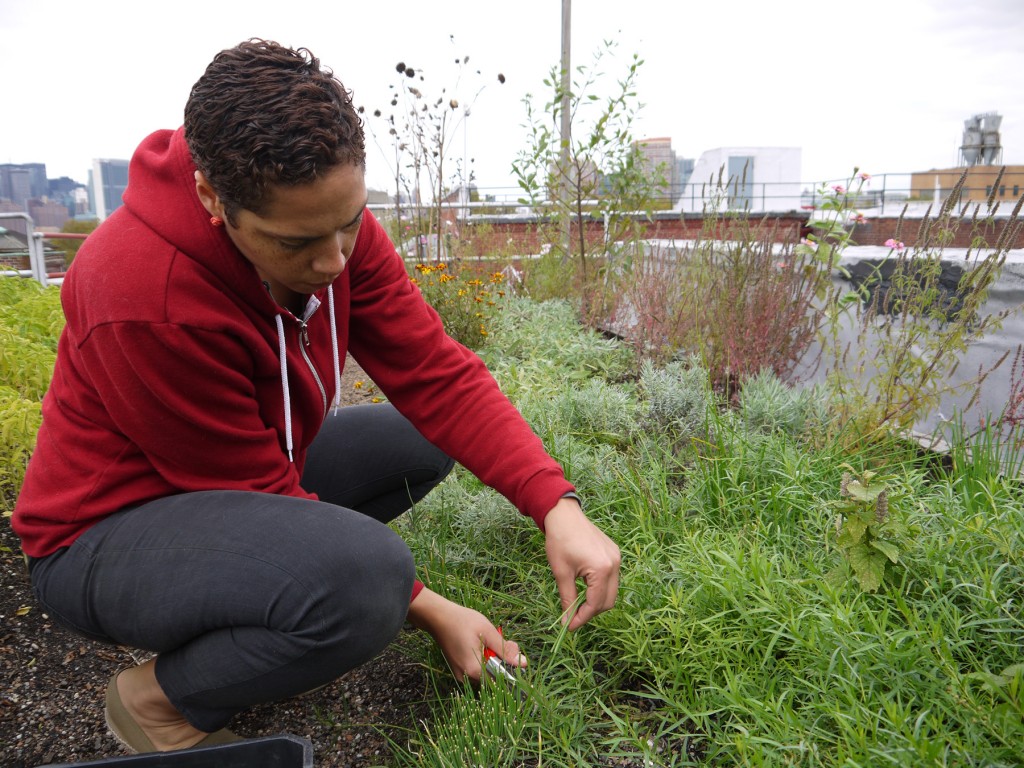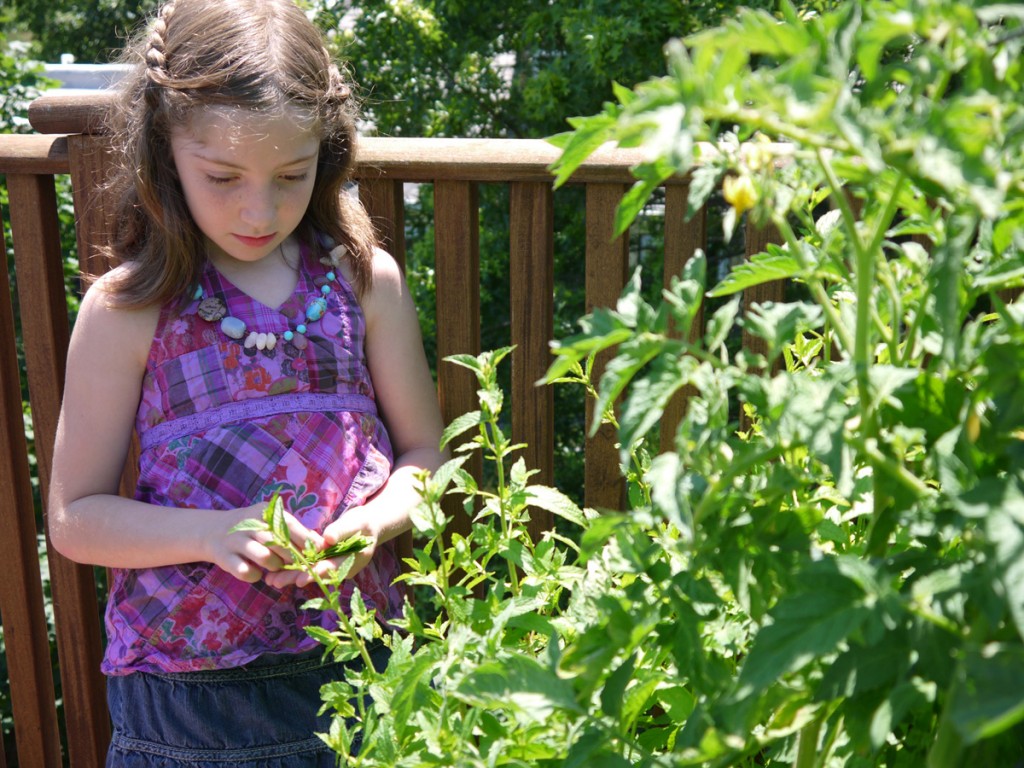ruminating on rain barrels

Herb pruning at Eagle Street Rooftop Farm || photo by Lauren Mandel
Winter is the perfect time for gardeners and farmers to rest, plan for spring planting, and investigate big questions that sprouted during the past growing season. My big question this winter: Is it safe to water edibles with roof runoff?
As a green roof designer I regularly work with architects and building owners to select waterproofing membranes for large green roof projects (generally 5,000 square feet to several acres in size). We discuss the pros and cons of each waterproofing material, such as cost, ease of install, and compatibility with leak detection technology. What we do not discuss is whether it’s safe for water flowing over the waterproofing to be collected for crop irrigation. Why don’t we discuss this? Because until recently the simple answer was, “not a chance!” Waterproofing (like PVC, TPO, hot liquid-applied rubberized asphalt, and even asphalt shingles) contains toxic elements and compounds that leach into runoff. Watering crops with this contaminated water douses your food with toxins like chromium, copper, zinc, cadmium, and lead. Pathogens like coliform bacteria and Escherichia coli can also enter the water from rooftop bird droppings.

Home rooftop gardening in West Philadelphia || photo by Lauren Mandel
For decades, though, homeowners have directed runoff from roofs into rain barrels to irrigate ornamental and edible plants. In cities, rain barrels are often located on balconies (for watering rooftop edibles), back patios, or near front stoops. Rain events fill the barrels, then water is released through a spigot or into a gravity-fed hose or drip irrigation system. Have these gardeners been poisoning their families?
New information suggests that using roof runoff to irrigate edibles may be A-OK, with a few caveats. A January 7 article by Lisa Stiffler in Sightline Daily – a digital publication by Seattle sustainability think tank, Sightline Institute – summarizes the findings of three recent scientific studies that investigated this very issue. The first is a Journal of the NACAA article by Haberland, Bakacs, and Yergeau (2013) that monitored toxins (lead, zinc, coliform bacteria, E. coli, and polycyclic aromatic hydrocarbons) in six urban and six suburban rain barrels, supplied by runoff from asphalt shingle roofs in New Jersey. The study found that, left untreated, the water contained levels of E. coli exceeding that recommended for crop irrigation by the U.S. Food and Drug Administration. The second highlighted study is a Washington State Department of Ecology publication by Winters, McCall, and Kingfisher (2014), which studied toxin concentrations in runoff over time as waterproofing materials whether. Researchers monitored toxin levels (arsenic, cadmium, copper, lead, zinc, and organic compounds) in runoff from 18 constructed roofing panels during an 11 month period. The study finds that:

Harvesting home rooftop herbs || photo by Lauren Mandel
Across the 20 rain events, [Washington State Department of Ecology] found that asphalt shingle, built-up, modified-built-up, TPO without brominated flame retardant, concrete tile, and untreated wood shingle roofing materials did not release elevated levels of the metals or organic compounds evaluated in runoff.
The study includes several recommendations for assessing the roof condition and its runoff, which are relevant to rain barrel use. The third study is a PLOS One article by Tom, Fletcher, and McCarthy (2014) tested heavy metal uptake by French bean (Phaseolus vulgaris), kale (Brassica oleracea var. acephala), and beetroot (Beta vulgaris) in Melbourne, Australia. Researchers watered the crops for 11 weeks with synthetic stormwater then tested for elements (cadmium, chromium, lead, copper, and zinc). The study found that lead uptake was most significant, but some crop varieties contained higher concentrations than others. For example, kale and beet roots contained lower metal concentrations than French beans and beat greens. The study recommends being selective about crop types and turning soil regularly when watering crops with roof runoff.
Suggested Guidelines when Watering Crops with Roof Runoff*
1| Be selective about the roofing material: Do not water crops with runoff from treated wood-shake roofs; roofs treated with chemicals to kill moss, algae, or rot; roofs with zinc strips; copper roofs; or roofs with copper gutters.
2| Don’t collect the “first flush”: Divert runoff from the first few heavy storms after a dry spell away from crops, into the storm drain.
3| Add bleach: Rutgers researchers recommend adding approximately one ounce of household unscented chlorine bleach to 55 gallons of water to kill the bacteria, then waiting 24 hours before watering.
4| Water the soil, not the food: Some soil microorganisms are able to break down certain toxins. Allowing these microorganisms to come in contact with the water before the plants do may decrease soil contamination.
5| Wash produce: Washing home-grown fruits, veggies, and herbs grown with harvested rainwater can help remove surface contaminants.
6| Clean the rain barrel: Rinsing the rain barrel on occasion can help remove particulate and bacteria. Some recommendations include mixing 1/8-cup chlorine bleach with five gallons water, then rinsing the barrel clean with municipal water.
* These guidelines are included in the Sightline Daily article referenced above, and are not expressly recommended by EAT UP, LLC. It is each gardener and farmer’s sole responsibility to decide whether or not to water edible crops with rooftop runoff. Local and national guidelines should always be adhered to for the protection of human health.
 EAT UP
EAT UP